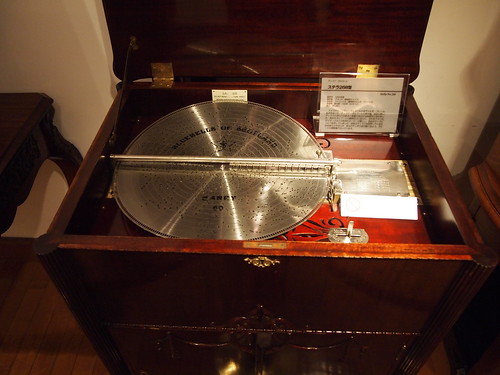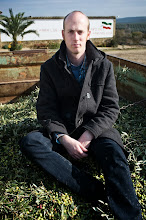Japan 1: Rokko Mountain
I've just been to Japan for two weeks. One day, we went up a mountain near Kobe in dense fog.

The funicular ride up Rokko Mountain trickled through the fading light and hazy tunnels. The machinery grinding loudly and slowly, to let you know how hard it was working, was kind of reassuring - is there anything more unsettling, more phantom, than car adverts boasting of noiseless vehicles? It was late afternoon on a week-day, off-season, in driving rain - so unsurprisingly, this tourist attraction was almost completely deserted. Everything in Japan has a theme or audiologo, and on the funicular a soft but cheesily emotional tune played, stirring strings straight out of a David Lynch film (advance warning: everything felt like it was out of a David Lynch film).

At the top we got to a kind of half-way house, with look-outs and coin-operated telescopes. We could see nothing but rain, in any direction. "The view is normally really beautiful" laughed Junichi, as we looked out on an ocean of grey sky.

In a cafe by the view-point, they were preparing for a gig later that evening, and playing a cover version of 'Wonderful Tonight'. This welling emotion in a well-lit building, isolated warmth amidst such sparse, unpopulated space creeped me the fuck out. It sparked the same kind of unease as the use of 'Llorando', the Spanish version of Roy Orbison's 'Crying', in Mulholland Drive. Meanwhile, the sonic effect of the downpour outside was like the muffling effect of snowfall: the heavier the rain, the more silence it generates, drowning out all other natural noise.
With nothing to see except our reflection in the puddles, we took another bus, even further up the mountain. Here we found a hill-walk garden with a path through the middle, which you can see in the next video. At the bottom of the hill was the lodge from Twin Peaks.
"This is perfect light for cinematography" Chloe told me. "The light is completely flat. There are no shadows."
The pre-dusk greylight was even more powerful than the rain, drowning all its victims – though this didn't stop the life beneath it trying to fight back. A brown ferret type creature darted under the raised wooden walkway, the leaves sprung back under the weight of the raindrops. In the distance, at the bottom of the hill, fog rolled across the path. To the left, a couple of lights from the lodge glow dimly in the mist. 'The Hall of Halls' is a rococo relic from another world, crafted with deliberate Japanese care, a spaceship from 19th century Switzerland which has (gently) crash-landed out of the blank sky.

It only got more creepy when we got inside - The Hall of Halls is, we discovered, a music box museum: celebrating self-playing-pianos, wind-up music-boxes, and other weird, weird stuff from 19th century Switzerland, Austria and Germany. In Japan. In 2011. When it first hoved into view my main thought was ‘we’re definitely going to get killed here’.
Here's a bit of what it sounded like:
They really didn't miss a beat making sure everything fitted the theme just right: from the cafe serving chicken schnitzel, to the postcards of medieval European banquets and maps of Austria in the gift shop.

In the high-beamed main exhibition room (presumably The Hall of Halls for which it was named), the museum attendants, all young Japanese women, wore round-toed fat black sandals with black stockings and festive green and red fin de siecle German smocks and aprons. It had player pianos, harpsichords, a ‘maccordian’, a ‘polyphon’, about 20 in all, ranging from modest liquor cabinet-size, to grandiloquent church organ. The baroque wooden ornamentation and stately church organ pipes stood out against the high beams and the plain white gloves of the museum attendants operating them. From the machines came The Carpenters ‘On Top Of The World’, 'Somewhere Over The Rainbow', and a Sound of Music medley, plinking and plonking with barely disguised aggression.


Outside in the corridor, there was a framed black and white billboard reproduction of an old advert from a periodical called The Music Trade Review: ‘THE AMERICAN PLAYER PIANO IN THE HOUSE is the Delight of the AMERICAN GIRL’
It was accompanied by a drawing of an American girl, looking Delighted.

In another room there were frayed-edged black and white pictures of children, with one or two features of each coloured by hand – a red flower here, and a blue trim on a night-shirt there: flashes of life in a time-worn cadaver of another period. Artificial attempts to bridge life and death ringing out everywhere. Next to them in the display case were several big blueprint-style drawings inspired by the music boxes, with phrases like ‘phantoms of premonition’, ‘unknown memories’, and ‘at the tarminal, the extention of their paradoxical rhythm’.
“In Japan, tapirs eat your nightmares”, Junichi chipped in as we looked at a pencil line-drawing of a tapir.

The question that was bothering me was just 'why?' Why this particular museum, up a mountain in Japan? In 2011? I worked it out while trying to sleep on the floor of a ferry later that night. Some of Japan's main obsessions: with cuteness, with the literal mechanics of progress through technology, with the futurism of miniaturisation, meant it made perfect sense. Japanese innovation in technology – especially entertainment technology – defined the 1980s and 1990s, and did wonders for the country's economy and presence on the world cultural stage. So of course they'd want to look back fondly on a time when another culture sought to do the same.
Why would you play the piano when it can play itself? Why would you play tennis when you can play Wii Tennis? Dead labour, live entertainment.
We were the last ones to leave.

The funicular ride up Rokko Mountain trickled through the fading light and hazy tunnels. The machinery grinding loudly and slowly, to let you know how hard it was working, was kind of reassuring - is there anything more unsettling, more phantom, than car adverts boasting of noiseless vehicles? It was late afternoon on a week-day, off-season, in driving rain - so unsurprisingly, this tourist attraction was almost completely deserted. Everything in Japan has a theme or audiologo, and on the funicular a soft but cheesily emotional tune played, stirring strings straight out of a David Lynch film (advance warning: everything felt like it was out of a David Lynch film).

At the top we got to a kind of half-way house, with look-outs and coin-operated telescopes. We could see nothing but rain, in any direction. "The view is normally really beautiful" laughed Junichi, as we looked out on an ocean of grey sky.

In a cafe by the view-point, they were preparing for a gig later that evening, and playing a cover version of 'Wonderful Tonight'. This welling emotion in a well-lit building, isolated warmth amidst such sparse, unpopulated space creeped me the fuck out. It sparked the same kind of unease as the use of 'Llorando', the Spanish version of Roy Orbison's 'Crying', in Mulholland Drive. Meanwhile, the sonic effect of the downpour outside was like the muffling effect of snowfall: the heavier the rain, the more silence it generates, drowning out all other natural noise.
With nothing to see except our reflection in the puddles, we took another bus, even further up the mountain. Here we found a hill-walk garden with a path through the middle, which you can see in the next video. At the bottom of the hill was the lodge from Twin Peaks.
"This is perfect light for cinematography" Chloe told me. "The light is completely flat. There are no shadows."
The pre-dusk greylight was even more powerful than the rain, drowning all its victims – though this didn't stop the life beneath it trying to fight back. A brown ferret type creature darted under the raised wooden walkway, the leaves sprung back under the weight of the raindrops. In the distance, at the bottom of the hill, fog rolled across the path. To the left, a couple of lights from the lodge glow dimly in the mist. 'The Hall of Halls' is a rococo relic from another world, crafted with deliberate Japanese care, a spaceship from 19th century Switzerland which has (gently) crash-landed out of the blank sky.

It only got more creepy when we got inside - The Hall of Halls is, we discovered, a music box museum: celebrating self-playing-pianos, wind-up music-boxes, and other weird, weird stuff from 19th century Switzerland, Austria and Germany. In Japan. In 2011. When it first hoved into view my main thought was ‘we’re definitely going to get killed here’.
Here's a bit of what it sounded like:
They really didn't miss a beat making sure everything fitted the theme just right: from the cafe serving chicken schnitzel, to the postcards of medieval European banquets and maps of Austria in the gift shop.

In the high-beamed main exhibition room (presumably The Hall of Halls for which it was named), the museum attendants, all young Japanese women, wore round-toed fat black sandals with black stockings and festive green and red fin de siecle German smocks and aprons. It had player pianos, harpsichords, a ‘maccordian’, a ‘polyphon’, about 20 in all, ranging from modest liquor cabinet-size, to grandiloquent church organ. The baroque wooden ornamentation and stately church organ pipes stood out against the high beams and the plain white gloves of the museum attendants operating them. From the machines came The Carpenters ‘On Top Of The World’, 'Somewhere Over The Rainbow', and a Sound of Music medley, plinking and plonking with barely disguised aggression.


Outside in the corridor, there was a framed black and white billboard reproduction of an old advert from a periodical called The Music Trade Review: ‘THE AMERICAN PLAYER PIANO IN THE HOUSE is the Delight of the AMERICAN GIRL’
It was accompanied by a drawing of an American girl, looking Delighted.

In another room there were frayed-edged black and white pictures of children, with one or two features of each coloured by hand – a red flower here, and a blue trim on a night-shirt there: flashes of life in a time-worn cadaver of another period. Artificial attempts to bridge life and death ringing out everywhere. Next to them in the display case were several big blueprint-style drawings inspired by the music boxes, with phrases like ‘phantoms of premonition’, ‘unknown memories’, and ‘at the tarminal, the extention of their paradoxical rhythm’.
“In Japan, tapirs eat your nightmares”, Junichi chipped in as we looked at a pencil line-drawing of a tapir.

The question that was bothering me was just 'why?' Why this particular museum, up a mountain in Japan? In 2011? I worked it out while trying to sleep on the floor of a ferry later that night. Some of Japan's main obsessions: with cuteness, with the literal mechanics of progress through technology, with the futurism of miniaturisation, meant it made perfect sense. Japanese innovation in technology – especially entertainment technology – defined the 1980s and 1990s, and did wonders for the country's economy and presence on the world cultural stage. So of course they'd want to look back fondly on a time when another culture sought to do the same.
Why would you play the piano when it can play itself? Why would you play tennis when you can play Wii Tennis? Dead labour, live entertainment.
We were the last ones to leave.

.jpg)




1 Comments:
I went up Rokko mountain when I was six. It was raining then too.
Post a Comment
Subscribe to Post Comments [Atom]
<< Home